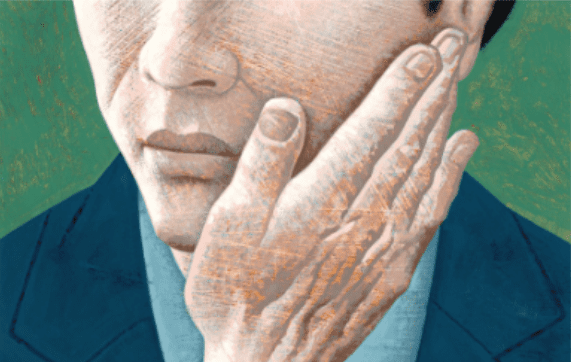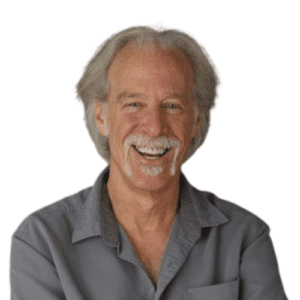It’s been years since I’ve had a substantial conversation with my mother, who years ago was diagnosed with dementia. But recently during a visit with her at her apartment in New York, as we sat over bagels, lox, and cream cheese at her kitchen table, I looked up to see her gazing adoringly at me, an unexpected twinkle in her eye.
Completely startled, I did a double-take.
At breakfast the next morning, she reached across the table and grabbed my right hand, placing our two palms together, and began to marvel at how similar they were: their size, their shape, and the way they fit together. Then she slowly pushed her palm away from mine so that only our fingertips were touching, and then back to prayer formation.
Later at lunch, she reached up, cupped my face in her hands like a vase, and looked at me tenderly.
The following morning, she leaned over and slowly traced the contours of my Fu Manchu moustache with her finger while I stared at it cross-eyed. She ran her finger along each section—across the top, down each side, and over the patch beneath my lower lip—saying, in a childlike, singsongy voice, “You have this. And this. And this.”
What made these moments so striking was how unprecedented they were. My mother had never been comfortable with this level of intimacy, or any emotional or physical expression of feeling. In most of the photographs taken of us together over the years, we look like two people standing next to each other in a police lineup.
Faced with this sudden display of affection, I felt both delight and bewilderment, along with a large dollop of umbrage—as in, where has this been my whole life?
Having grown up rarely seeing any display of maternal tenderness, I thought I knew the kind of person my mother was and what I could expect from her. But suddenly, the person in front of me was different, forcing this old dog to struggle with a few new tricks and let go of a few grudges.
At first, I told myself that this new behavior was a product of the dementia, not who my mother really was. But just as likely, this was my mother, and had been all along. Only hidden. And now here, toward the end, the dementia was bringing down the walls of her inhibitions. Her steely personality was falling away, and here was a softer, more touching and feeling person underneath, someone capable of spontaneously reaching to cup my face in her hands.
Yet this encounter was merely a prelude to a far more startling realization, which further rearranged my long-held narrative about my mother. It happened on my next trip to New York, when I’d gone back to her apartment to preside over the dismantling of her vast empire of earthly possessions, the product of 85 years’ worth of hoarding, which needed to be cleared out before she could move to a nursing home in California.
The first morning, I came across a set of olive-colored file cabinets that had always been in my mother’s office in the house where I’d grown up, but was always locked and off-limits.
All my mother had ever told me was that they contained her “personal papers.” And some of them, I soon discovered, were of the sort that, had the dementia not caught up with her so quickly, I imagine she’d have chosen to destroy before anyone could read them—or maybe not. Maybe leaving them intact was a confession of sorts.
So while my mother sat in a nursing home 3,000 miles away, drifting farther and farther out to sea on the outgoing tide of her dementia, I poured myself a glass of bourbon from the living-room bar and stood before those forbidden file cabinets, keys in hand.
First, I uncovered a four-page love letter written to my mother by a man who was apparently in the running for her hand in marriage but lost out to my father. I found photographs of my mother naked—an acquired taste, if ever there was one. I found duplicates of letters full of love and admiration, that my mother had written to my brothers and me during our 20’s and 30’s, which stood in stark contrast to my view of her as being largely aloof, critical, and controlling. I’d simply forgotten about them, perhaps in an unconscious effort to support my story of victimization vis-à-vis my mother.
I found a half-empty bottle of morphine in a box filled with literature about a right-to-die organization called the Hemlock Society, of which my mother was clearly a card-carrying member. According to some of the correspondence in that box, she’d apparently used the morphine to help her sister, my aunt Helen, not just cope with but perhaps die of cancer—an act of compassion that would be called assisted suicide in states like Oregon and Vermont, but would go by a very different name in the state of New York.
I also found a series of arrest records for domestic abuse going back to the earliest years of my mother’s marriage to my stepfather, along with inch-thick court transcripts, photographs, and videotapes of the bruises she’d sustained—something I’d had no inkling of while growing up. There was one particularly gruesome file titled “Charles’s Reign of Terror,” in which she documented his attempts over the years, as he himself apparently said to her, “to drive you out the door—or out the window.” He succeeded at neither, and she stayed married to him for 30 years.
My mother isn’t the type to shy away from a fight or take life sitting down. She was one of the first women stockbrokers on Wall Street, who’d once bought a nutcracker in the shape of a woman’s legs. So why, I wondered, would she put up with such abuse? Why wouldn’t she just walk out the door?
There wasn’t a clue in those file cabinets that would help me answer that question, but I do know that where there’s big light, there’s big shadow. And after going through my mother’s personal papers, I know more clearly than ever that the stories I’d long told myself about my parents and my childhood were clearly incomplete, made from shreds of evidence, cemented in place by repetition and generalization. Could they have been only a conjuring-up of explanations that made sense to my childish grasp of things, even though they then became the foundation of my philosophies of life and love, for better and for worse?
For instance, from what I perceived to be my mother’s wary and defiant nature, I concluded that life is precipitous and independence paramount, and I’ve largely lived by those creeds. But going through my mother’s personal papers showed me—and reminded me—that this is not the whole story, of either my life or her life, or anybody else’s.
I recently read that the ancient Greek and Roman marble sculptures that populate our museums weren’t originally white. In fact, they were richly painted with colors. White is simply all that was left after they’d gone through time’s stomach acids. I realized that what had come down to me from my own past had similarly been whitewashed.
It’s tempting to think I’ve got everything squared away in boxes, my life stories carefully arranged, with all the actors in their places. How unsettling, but also renewing, to be reminded of how important it is to upgrade my files when new evidence unexpectedly appears, to clean my caches, as they say in cyberspeak, and to question and review the stories that guide my journey through time?
Illustration © Adam Niklewicz
Gregg Levoy
Gregg Levoy is the author of Callings: Finding and Following an Authentic Life and Vital Signs: The Nature and Nurture of Passion.












